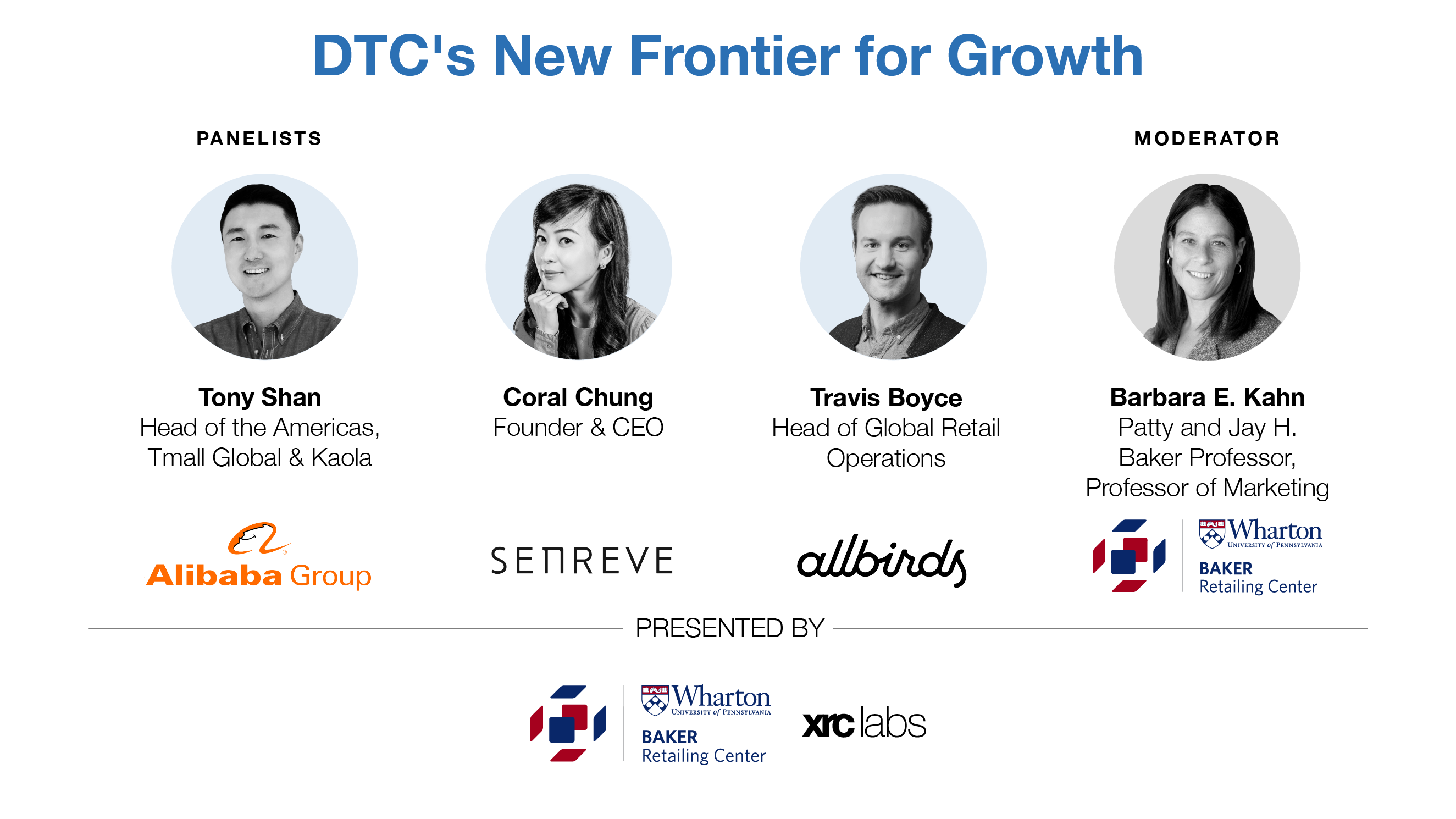


It’s no secret that direct-to-consumer (or DTC) brands have been at the forefront of changing the way consumers shop. So it’s no surprise that many of them not only survived the pandemic, but actually thrived. With agile business models and digital strategies, they were well positioned to navigate a world of closed brick-and-mortar retail.
This was the theme of the “New Frontier for Growth” session at the 2021 Retail Innovation Summit hosted by the Wharton School’s Baker Retailing Center and XRC Labs. (Watch a replay here.)
Moderated by Barbara Kahn, Professor of Marketing at the Wharton School, the panel featured Travis Boyce, Head of Global Retail Operations at sustainable footwear brand Allbirds and Coral Chung, Founder and CEO of luxury leather handbag company Senreve. Joining them was Tony Shan, Head of Alibaba’s Tmall Global for the Americas. One thing these two brands have in common is their choice of Alibaba as a partner to enter China. During the event, they discussed what distinguishes Alibaba’s marketplaces from other global e-commerce platforms, and why they made an exception to their direct-to-consumer model in China.
The beauty of a DTC model
When asked “Why DTC?”, both Boyce and Chung noted two key reasons. First, being able to provide high-quality products at accessible price points. Second is being able to own their relationships with their customers. Not only do they want to be able to communicate their brand values directly to their consumers, they rely on that direct feedback from them to improve their products and inform their product innovation and assortment.
Why DTC brands are working with Alibaba
Like most DTC brands, Allbirds and Senreve have resisted selling on well-known e-commerce sites. Yet both chose to access the China consumer market with Alibaba’s B2C platforms Tmall and Tmall Global. The reason comes down to what Alibaba’s Shan noted: “We are a marketplace, not a retailer. We only do well if brands do well.” The best way to think of Tmall and Tmall Global, Shan said, is a digital mall where consumers can “go” to engage with brands directly.
Chung of Senreve noted that Tmall Global provides exactly the kind of consumer she is looking for – those looking for premium and luxury products, in contrast to those looking for mass-market items on online shopping platforms in the West.
Through Tmall Global, Senreve was also able to access consumer demographics and analytics, which allowed her to learn more about Senreve’s consumers in China and to do product localization. Chung learned her average Chinese customer is 10 years younger than her US counterpart. And since customer engagement and satisfaction is very important in the China market, Senreve found the ratings and reviews particularly useful, prompting her to upgrade her brand’s packaging.
“Having data is important for DTC decision making,” said Shan of Tmall Global. “We share sales info, traffic, CRM management system and macro trends for brands who have flagship stores on our platforms.” Chung said that being able to have that data as well as transparency on competitive benchmarking has been useful for growing her brand.
For Allbirds, the journey to China began when they noticed strong upticks of Chinese consumers looking at their website, as well as Chinese tourists buying significant amounts of product from their brick-and-mortar stores to bring home to their families. Realizing that there was a demand for sustainable yet stylish and comfortable shoes on the other side of the world, they moved to enter the China market right away.
Boyce noted that not only did they invest in physical retail and establish four owned-and-operated stores, they also partnered with Tmall to help build its visibility, engage with consumers and amplify its storytelling around its brand’s mission of sustainability.
Why DTC brands did well during the pandemic
When the world shut down and the retail world took a hit, Allbirds and Senreve were forced to adapt their businesses to survive the pandemic.
Boyce of Allbirds explained how a mobile-first mindset, which was already popular in China even before the pandemic, became the foundation for their innovations in the US. Allbirds developed its own mobile app with augmented reality technology for users to virtually try on Allbirds shoes, a feature that is already quite popular in China.
Boyce also commented on the acceptance of QR codes in the US, which grew in popularity during the pandemic as restaurant goers had to use them to see menus. Now that consumers are accustomed to them, Allbirds is exploring how to use them for richer storytelling that would enhance the in-store experience.
Luxury was one of the first industries to take a hit during the pandemic, but Senreve actually generated significant growth. Already a geographically diverse brand with 50% of sales coming from outside of the US, Senreve was able to double down on regions such as China that recovered from the pandemic at a quicker pace.
The company also experimented with livestreaming with Alibaba to build brand awareness, outperforming some of the most well-known international luxury brands. Chung explained how the technology allowed them to engage with curious potential consumers by demonstrating different ways of wearing the bag and answering questions from customers in real-time.
Chung also gave an example of how different markets sometimes require different marketing strategies – in the US, Senreve’s brand focuses solely on women, but in China, male influencers and KOLs are very popular. So Senreve tested a livestream with a male KOL, which ended up performing very successfully for the brand.
Future growth is digital and global
For Allbirds, the future holds exciting opportunities across the globe, including the China market. Allbirds continue to see physical storefronts as a huge opportunity for its brand but will also continue to invest in its mobile app and e-commerce capabilities to engage with its consumers.
Senreve is continuing its aggressive global growth. The brand opened up two physical stores in Hong Kong and Singapore, as well as a pop-up in Chengdu. Through the pandemic, Senreve learned that it was important for them to diversify their supply chain and build up global operational infrastructure, and they have set themselves up for effective inventory management down the line.
Consumer shopping behavior in China, and perhaps the rest of the world, has changed a lot in terms of the “where” and “how,” Shan pointed out. For brands, it’s important to think about digitization as reaching consumers where they actually are. Especially since global travel continues to be restricted, he predicts Chinese consumers’ travel budgets will go towards shopping and online consumption. “Brands need to be where consumers are,” he stressed. In 2020, China became the biggest and fastest-growing market for many brands and retailers. Last year, US brands made record sales of more than $54 billion to Chinese consumers on Alibaba’s marketplaces. Shan also pointed to growing purchasing power in China, citing a middle class bigger than the entire US population that is looking for high-quality products from around the world. “It’s never been more important or easier to go global,” he said.





